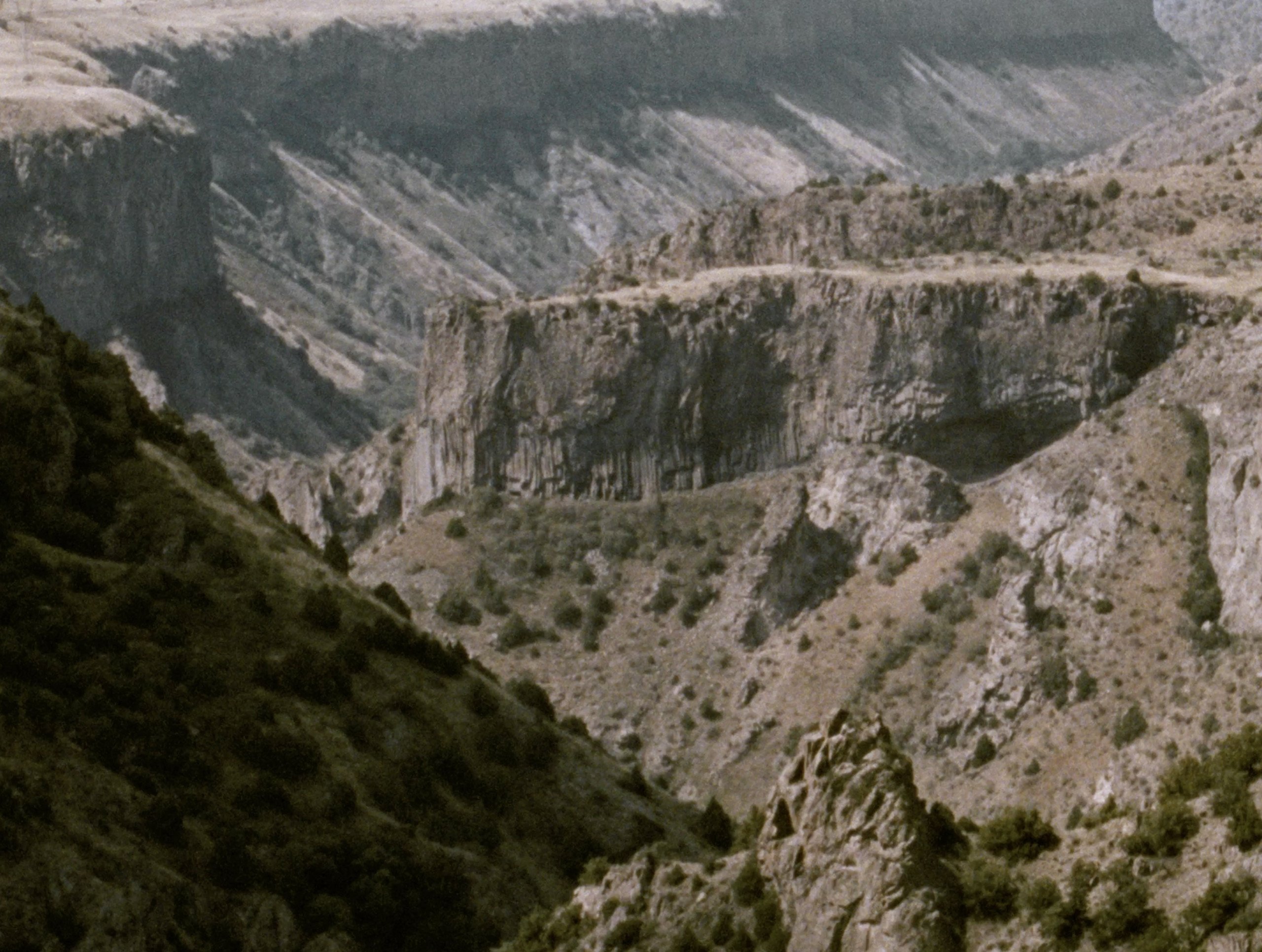End Pull is freely inspired by Michael Snow’s Wavelength (1967). Could you tell us about this reference? When did it come into play in the making of the film?
Michael Snow’s way of perceiving temporality as a spatial construct has always captivated me—that on-screen seance of hypnosis. But I approached Wavelength strictly as a method, a protocol of sorts, one which End Pull departs from rather quickly. For End Pull escapes the confines of an apartment in New York and transports the viewer into the Armenian mountains, allowing the gaze to wander freely in the vast landscape. The focus here is no longer fixed to a single point in a room, but instead it plunges into an ancient riverbed through geological formations and historical distortions. It’s this deliberate act of hypnotic transition—from interior to exterior, from human time to deep time—that became the central gesture of the film.
End Pull consists of a slow, continuous zoom whose movement is only interrupted by changes in light, suggesting that the film was shot at different times of the day and over several days. What were the film’s technical constraints? How did you work with your cinematographer?
End Pull was shot from a fixed camera angle, and the main constraints included the natural elements themselves—the scorching sun, the wind which visibly trembles the camera throughout the film. We used five lenses to manually zoom into the vast terrain, shooting the film through the course of a week. Since every focus pull had to be performed manually by the cinematographer Louis Braddock Clarke, I designed a score to guide each zoom in. Standing behind the camera, I would count out a repetitive rhythm: “and… pull…” indicating the next cue. This phrase, repeated every few seconds like a little mantra, became a refrain of the shoot itself and ultimately gave the film its title.
A conversation between two characters awakening from a very long sleep is gradually integrated into the image. Who are they?
The film is syncopated with a sparse dialogue between two Armenian-Zoroastrian demons by the names of Hārut and Mārut. These ancient spirits have been historically linked to magic, perfumery, alcohol brewing, and fiction. In the film, they appear awoken from their millennial slumber, hanging upside down in a cave, disturbed by the recent artillery fire and the mine drilling. Hārut and Mārut do not seem evil but they are not empathetic either, they exist in their unrelenting boredom, in a constant desire for disappearance. Ancient demons who have lost their paradise, but are unwilling—or perhaps unable—to fully withdraw.
The text has a metaphysical and spiritual dimension, with some contemporary references. How did you elaborate it?
The text has a tense relationship to the visuals, it interferes with and amplifies the slow moving zoom into the mountains. I wanted to write it analogous to how human time feels to geological time. The script had to be like the demons themselves, contradictory and slippery, without a need for clarity or reason. Hārut and Mārut are therefore ever-present as long as the film is watched. In the end, they overpower the camera and take over its final plunge into the darkness. Ruminating in a rambling fashion and relentlessly repetitive, they seem to me like children learning to play with a toy, slightly unconvinced yet at the same time very certain of their ways…
The film uses sound to create a hypnotic atmosphere. How did you work on the soundtrack? What was your approach? And how did you work with the texture of the voices?
Borrowing from Snow, I used a sine-wave generator but multiplied it by three. The soundtrack is built from the resultant tones—a psychoacoustic phenomenon where a “ghost note” appears in our heads when two tones are combined, a note which isn’t physically present. In the film, these ghost sounds gush like a wave with varying intensities, akin to the film’s ancient riverbed that once carried an evidently huge river. I filtered and distorted the sound at points, creating small islands of respite between the sine-wave pressure. The dialogue was recorded as a counterpart to it all, deliberately fragile, sleepy, not easy to grasp. With a play-like tone, the recording was done thinking of a disturbance, a rupture within the overall film’s continuous pull.
What are these mountains? What do they mean to you? Why did you choose not to give the film its geographical and geopolitical context?
End Pull was shot from my uncle’s small garden which has been in the family for generations. There were apricot fruits growing just behind our backs while we were shooting the film, and we even witnessed a murder of a snake. This is definitely an emotionally dear space for me. At the same time, the village has been marked by recent Azerbaijani shelling and gold mining by a Russian-British conglomerate, both of which disasters have greatly disturbed the local ecosystems. These events seeped directly into the writing and how I imagined the two demon characters for the film. For me, the film maintains its rootedness in the Armenian mountain landscape, but without focusing on that exclusively. After all, demons don’t subscribe to geopolitics.
Interview by Louise Martin Papasian
